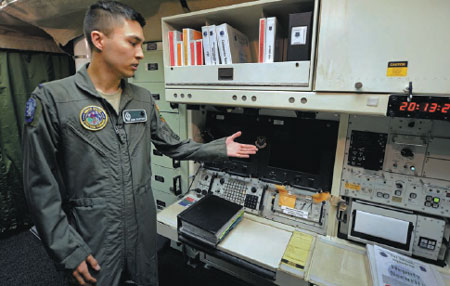Nuke missile duty weighs on officers' minds
Babysitting ICBMs in stuffy capsule, 'missileers' under immense pressure
Andy Parthum spends his workday 18.3 meters below ground awaiting the order he hopes never arrives: to launch the most powerful weapon ever devised by man. He is a nuclear "missileer" - a US airman who does his duty not in the air, but in a hole in the ground.
On both counts - the possibility of firing weapons that could kill millions, and the subterranean confinement - a missileer lives with pressures few others know. It's not active combat, although the US air force calls them combat crew members. Yet no one can exclude the possibility, remote as it may be, that one day a president will deliver the gut-wrenching order that would compel a missileer to unleash nuclear hell.
"Absolutely, it weighs on your mind," Parthum, 25, said on a recent afternoon at Juliet-01, a Minuteman 3 missile-launch site near Minot air force base, whose 91st Missile Wing controls 150 of the nation's 450 Minuteman missiles.
It may come as a surprise to some that the air force still operates intercontinental ballistic missiles, or ICBMs. And therein lies part of the problem for missileers, who feel underappreciated in a military that has long since shifted its main focus to fighting small wars, striking with unmanned drones and countering terrorism and cyberattacks.
Parthum, however, said he takes pride in his role.
"It's sobering. It's not something that's taken lightly by anybody," Parthum said as he and his crewmate, 23-year-old 2nd Lieutenant Oliver Parsons, showed visitors around the small launch-control center where they were several hours into a 24-hour watch over a group of 10 missiles.
It's a sometimes tedious duty the air force calls "standing alert". Some say their biggest challenge is staying alert.
Missileers, typically 22-to 27-year-old lieutenants and captains, work in pairs, with a relief crew arriving every 24 hours. A missileer generally does two "alerts" a week. It was Parthum's 118th.
It's not hard to see why some missileers find it hard to adjust to life there. An 8-ton blast door seals their launch control center from a potential incoming nuclear detonation. Twice last year, launch officers were disciplined after admitting they left the blast door open while a crewmate was asleep - a security violation. That and other lapses in discipline, training and leadership were documented by The Associated Press over the past year, prompting US Defense Secretary Chuck Hagel to declare "Something is wrong".
The ICBM launch control center is actually two separate structures. An outer protective shell is made of reinforced concrete lined with a steel plate.
A smaller, boxlike enclosure where the missileers work, eat and sleep is suspended inside the protective shell by pneumatic cylinders called "shock isolators" attached to the shell's ceiling by heavy chains; the isolators are designed to keep the space stable in the event of a nuclear blast.
These underground command posts have changed relatively little since they were built in the early 1960s, although the air force recently committed to refurbishing them to make a missileer's life a bit easier. Juliet-01, the command post that an AP reporting team was permitted to visit, had just been repainted and spruced up to remove corrosion caused by water intrusion, giving it what one officer called "that new car smell."
The launch center is accessible only from an above-ground building that resembles a small ranch-style home. An access shaft descends from a vestibule inside the building, which is controlled by a security team and surrounded by alarms and a chain-link fence.
The United States has never fired an ICBM other than for flight testing.
Their stated purpose is to help deter nuclear war by convincing a potential attacker that it would have more to lose than to gain.
ICBM duty is far removed from the glamour, guts and glory associated with the air force.
It not only falls short of the image of a fighter or bomber pilot streaking across enemy skies, it requires sitting, unseen and largely unappreciated, in a stuffy capsule to baby-sit missiles.
More than two-thirds of missileers were "volunteered" for the job after gaining their officer commission. Once they complete basic ICBM training, they are sent on four-year tours to one of three missile bases: Minot; Malmstrom air force base in Montana; or F.E. Warren air force base in Wyoming.
The responsibility is enormous, the cost of mistakes potentially colossal, ranging from environmental damage to inadvertently triggering a nuclear war.
Over time, with the passing of the Cold War, the air force lost focus on its nuclear mission. It also lost a good deal of what remained of the allure of serving as a missileer.
"Even during the Cold War while facing down the Soviets, it could be difficult to convince bright young airmen that what they were doing was worthwhile," Robert W. Stanley II wrote in a research paper in 2011 before becoming vice commander of the 341st Missile Wing at Malmstrom.
|
First Lieutenant Andy Parthum shows his work area in the underground control room at an ICBM launch control facility at Minot air force base in North Dakota. Charlie Riedel / Associated Press |
(China Daily 07/10/2014 page10)















